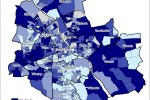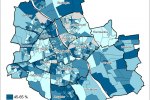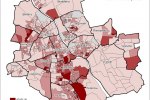 Warsaw. European Parliament Election, 2004
Warsaw. European Parliament Election, 2004
By Alex Kireev
Comment by Mariusz Kowalski – Electoral geography of Warsaw 2004
The period of 15 years of experience in democratic elections demonstrated a strong spatial differentiation of Poland in terms of electoral behaviour. This differentiation concerns both the relation between town and countryside, and the particular areas, whether within the urban or rural space (Kowalski, 2000, 2004).
Polish political space is divided into four basic political options: the rightist, the leftist, the liberal and the peasant. The primary political forces are the left and the right. Their influence is highly differentiated in particular rural areas, this fact being related to the strongly diversified historical conditioning in socio-economic terms. It is especially important to which of the neighbouring countries a given region of Poland belonged in the 19th century. This is less visible in the urban areas, where the differences in the influences between towns and their parts are not so clear any more. The fundamental difference between the urban and rural areas, however, consists in the differentiation of influence of the liberal and peasant options. Strong influence of the peasant option is characteristic only for the rural areas. In many places this option gains better electoral results than the leftist and the rightist options. Pronounced influence of the liberal option is characteristic for the urban and suburban areas (the latter ones being under the influence of towns). This option, as well, in many places outdistances the electoral strength of the left and the right (Kowalski 2000, 2004).
Warsaw does not differ significantly in terms of electoral behaviour from other large cities of Poland (Węcławowicz, Jarosz, Śleszyński 1998, Kowalski 2000). In the consecutive elections good results have been achieved by the liberal option (Liberal-Democratic Congress, Democratic Union, Union of Freedom, Citizen Platform, Union of Real Politics). While both the rightist parties (Centre Alliance, Christian-National Union, Electoral Action of Solidarity, Movement for the Reconstruction of Poland, Law and Justice, League of Polish Families) and the leftist ones (Alliance of Democratic Left, Union of Labour, Polish Social-Democracy) achieved good electoral results, it is the former that was distinctly better. The peasant option (Polish Peasant Party, Self-Defence) had marginal significance.
In Warsaw as a whole, and in the central quarters, quite pronounced differentiation of support for particular political options can be observed. The liberal option, as mentioned, characteristic for all the urban areas, gained the strongest support in the quarters considered to be “good” for decades – Żoliborz, Saska Kępa, eastern part of Ochota, western part of Mokotów. It gained a similarly strong support in the new housing estates, constructed in the recent years, but concentrating mainly in the outer belt of quarters (Kabaty, Nowodwory, Bemowo). In the central part Gocławek can be classified among such estates. The strict centre of Warsaw – the quarter of Downtown – was in these terms average. Taking into account the character of these quarters and estates, strong support for the liberal option should be associated with the voters belonging among the socio-economic elite: intellectuals, managers, free trade professionals (Fig. 1).
Strong influence of the left was characteristic first of all for the quarters, in which apartments had been given in the former period to the functionaries of the communist authorities: activists of the communist party, state officers, militiamen and the military. In the central part of town this concerned first of all the quarter of Mokotów and, to a lesser degree, southern Downtown, western part of Ochota and Gocławek. In the outer belt of quarters this applied to Bemowo and Rembertów (Fig. 2).
The support for the right was also differentiated. It was visible first of all in Wola, Grochów, Ochota, Praga North, in the quarters inhabited by the lower categories of employees (blue collar workers, technical personnel, clerks). In the outer quarters this concerned mainly the housing estates dating from the 1960s and 1970s (Bielany, Chomiczówka, Targówek), and the suburbs with the traditional family houses (Ursus, Wawer), dominated also by similar social groups. Low support for this option corresponded to strong influence of the liberals and the left. In the central quarters this was first of all the case of Mokotów, while in the outer quarters – of Bemowo and Ursynów (Fig. 3).
Observation of the electoral behaviour of the inhabitants of Warsaw provides additional information on spatial differentiation of the socio-economic development problems. Electoral behaviour clearly correlates with the appearance of clusters of characteristic social groups. Political divisions become an important element of the social differentiation of population, and also an important and simultaneously synthetic indicator of the economic condition of persons inhabiting particular parts of town.
Literature:
- Kowalski M., 2000, Geografia wyborcza Polski: Zróżnicowanie przestrzenne zachowań wyborczych Polaków w okresie 1989–1998. Geopolitical Studies, 7, IGiPZ PAN, Warszawa.
- Kowalski M., 2004, Regionalne zróżnicowanie zachowań wyborczych Polaków w latach 1989-2001, (w:) Markowski T. (red.) Przestrzeń w zarządzaniu rozwojem regionalnym i lokalnym, Biuletyn KPZK PAN 211, Warszawa, s. 407-430.
- Węcławowicz G., Jarosz A., Śleszyński P., 1998, Wybory parlamentarne 1991 i 1993, Atlas Warszawy, 3, IGiPZ PAN, Warszawa.




